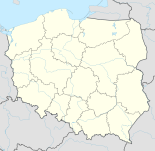Kolno (Nowa Ruda)
| Kolno | ||
|---|---|---|

|
|
|
| Basic data | ||
| State : | Poland | |
| Voivodeship : | Lower Silesia | |
| Powiat : | Kłodzko | |
| District of: | Nowa Ruda | |
| Geographic location : | 50 ° 35 ' N , 16 ° 31' E | |
| Height : | 400-450 m npm | |
| Residents : | ||
| Postal code : | 57-400 | |
| Telephone code : | (+48) 74 | |
| License plate : | DKL | |
| Economy and Transport | ||
| Street : | Ext. 381 | |
Kolno (German Kohlendorf ) is a district of the municipality Nowa Ruda ( Neurode ) in the Lower Silesian Voivodeship in Poland .
geography
Kolno is located two kilometers northeast of the city center of Nowa Ruda on Voivodeship Road 381, which runs from Kłodzko ( Glatz ) to Wałbrzych ( Waldenburg ). Neighboring towns are Jugów ( Hausdorf ) in the north, Przygórze ( Köpprich ) in the northeast, Wolibórz ( Volpersdorf ) in the east, Włodowice ( Walditz ) in the southwest and Drogosław ( Kunzendorf ) in the northwest.
history
Kohlendorf, whose area belonged to the former Bohemian county of Glatz , was founded around 1770 by the neuroder landlord Stillfried . As early as 1742 with the Peace of Berlin , which was again confirmed with the Hubertusburg Peace of 1763, the area of Kohlendorf fell to Prussia together with the County of Glatz . In 1810 August von Stillfried sold the Neurode estate to Anton Alexander von Magnis on Eckersdorf . After the reorganization of Prussia, from 1815 Kohlendorf belonged to the province of Silesia , which was divided into districts. The district of Glatz was responsible from 1816–1853, and the district of Neurode from 1854–1932 . After its dissolution in 1933, Kohlendorf again belonged to the district of Glatz until 1945. Since 1874 the rural community Kohlendorf belonged together with the rural community Kunzendorf to the administrative district Kunzendorf.
From the beginning, the mining of coal in the Rubengrube, as well as agriculture and house weaving, were of economic importance. Further economic development was favored in 1880 with the commissioning of the Waldenburg – Glatz railway line , which had a stop in Kohlendorf. In 1936 Kohlendorf was incorporated into the city of Neurode. On May 10, 1941, 187 miners were killed in the Rubengrube in Kohlendorf by a carbon dioxide outbreak.
As a result of the Second World War , Kohlendorf fell to Poland in 1945 and was renamed Kolno . Most of the German population was expelled in 1946, unless they had fled before. Some of the newly settled residents were displaced from eastern Poland . The Rubengrube was renamed "Kopalnia Węgla Kamiennego Nowa Ruda - Pole Piast". From 1954 to 1975 Kolno and Nowa Ruda belonged to the powiat noworudzki ( powiat Nowa Ruda ), then until 1998 to the Wałbrzych Voivodeship . After the political change, the Kopialnia was closed in 1994.
Attractions
- Mining museum
literature
- Hugo Weczerka (Hrsg.): Handbook of the historical places . Volume: Silesia (= Kröner's pocket edition . Volume 316). Kröner, Stuttgart 1977, ISBN 3-520-31601-3 , pp. 89 and 350.
- Peter Güttler: The Glatzer Land . Travel guide published by Aktion West-Ost in the BDKJ, Düsseldorf 1995, ISBN 3-928508-03-2 , pp. 9-11
Web links
- Historical and current recordings as well as geographical location
- Historical and current photos of the former "Rubengrube", after 1945 the "Piast" mine
- Viaduct on the Kłodzko – Wałbrzych railway line ( Glatz – Waldenburg )
- Historical recordings
